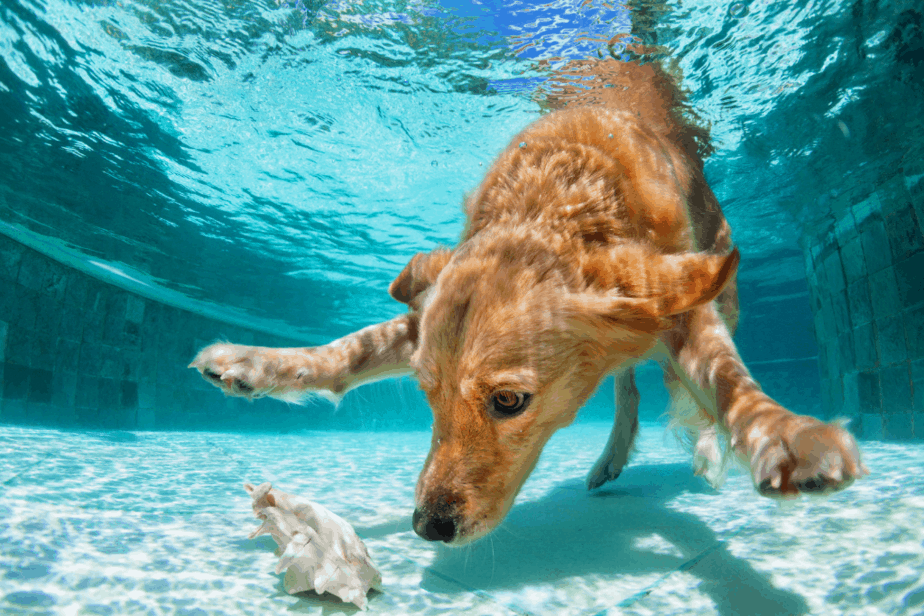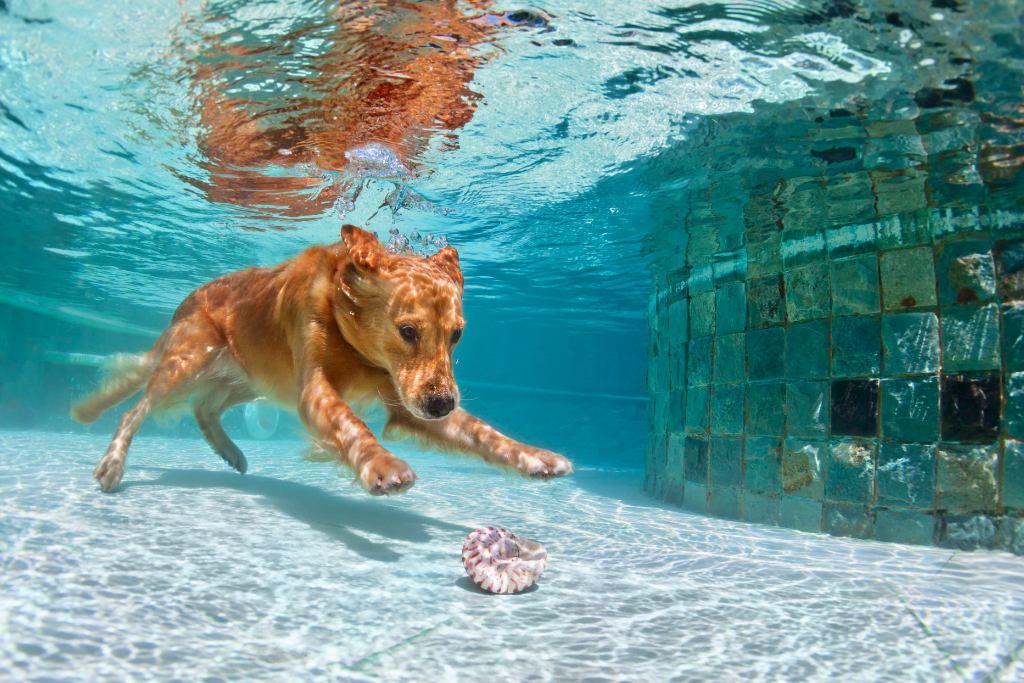The best way to keep your dog cool during the summer is by giving them a refreshing dip in the pool. Most dogs love swimming and will jump straight in to retrieve their toys. Some dogs are even known to dive to the bottom of the pool to rescue that toy.
So does this mean that dogs can hold their breath underwater?
The short answer Yes! Dogs can hold their breath underwater. However, this is not a good idea and you should never encourage your dog to do so. While some dogs can do this naturally others cannot and can drown if you let them stay under too long.
If you’re worried about this and you want to stop your dog from diving underwater there is a way to stop this and at the same time keep your dog safe while splashing around in the water and that’s to use a life jacket this should prevent them from diving.

How Do Dogs Hold Their Breath Underwater?
So how do dogs know to hold their breath underwater? Well, it’s called the mammalian diving response that kicks in when dogs are submerged underwater.
This response is common in mammals and will override other unconscious functions, like breathing. It’s amazing how this physical response can keep your dog safe and! alive when they’re submerged underwater.
Some dogs can hold their breath longer than others, which is why some breeds are more suited to water activities like retrieving objects from the bottom of pools or lakes.
These breeds include Newfoundlands and Golden Retrievers, as their larger lungs can store more oxygen in them for diving purposes.
Other less-susceptible breeds such as Basset Hounds and Pugs should be watched closely while swimming and should not be left unattended around water
Mammalian Diving Response
The mammalian diving response was first described in 1786 by Edmund Goodwyn but it wasn’t until an 1870 publication by Paul Bert for the physiologic adaptations to be recognized.
The response is a natural reflex when animals dive underwater. It prevents the lungs from collapsing when underwater. This allows for prolonged submersion without breathing.
The mammalian diving response is characterized by the Following…
- Bradycardia: If the heart is betting fast then the body requires more oxergan but Bradycardia accally lowers the heart rate meaning that the dog can hold their breath longer
- Peripheral Vasoconstriction: narrows the blood vessels that reduces blood flow and as a result, conserves oxygen for the organs require it the most.
- Blood Flow: When the dog’s body reduces blood flow this also works to their advantage and able them to dive deep enough where their body can handle any slight changes in pressure.
Furthermore, due to these physiological adaptations other mammals like dolphins for example, are able to hold their breath underwater significantly longer than dogs. Some are capable of remaining submerged for 8 to 10 minutes.
Related Article:

How Long Can Dogs Hold Their Breath Underwater?
The answer to this question is not as long as you might think. In fact, there are many factors that come into play. This includes things like the dog’s size, age, and breed type all contribute to the amount of time a dog can stay underwater.
A dog will typically only hold their breath underwater for about 5 to 8 seconds just until they have retrieved their toy. However, as mentioned before there are other factors that come into play and this can vary on a case by case basis.
For instance, dogs with short noses will have difficulty holding their breath underwater because they need to use the nose more than others do when breathing.
As well, some breeds such as Basset Hounds and Pugs should not be left unattended while swimming due to low amounts of oxygen in the body’s tissues caused by limited lung capacity.
These types of breeds often suffer from respiratory problems like tracheal collapse which causes them to take frequent shallow breaths at higher rates – making it difficult for them to hold their breath for a long time.
How Deep Can They Dive?
Some breeds have been known to dive as much as 15 feet or more, but as before this largely depends on the breed and their lung capacity.
Greater lung capacity allows for a dog to go deeper when diving, and generally the size of their lungs decreases as they age. Newfoundlands are an exception in this case though because they have large lungs even when fully grown!
It’s also worth noting that dogs do not instinctively know how long it can take them to get back up – which is why you should never let your pup stay underwater for too long.
Can Dogs Be Taught To Hold Thier Breath Underwater?
No! It’s not possible to teach a dog how long they can hold their breath underwater. As mentioned, The canine diving response is an automatic reflex that kicks in when the dog dives underwater and cannot be taught.
If your dog doesn’t dive then leave it at that! never force them under the water to see how long they can hold their breath. Not only can this be very dangerous but this can also scare your dog from entering the water again.
It’s always better just to play with them in the water and let them retrieve their toys on their own accord.
Conclusion
So we hope this article has helped you understand how to keep your dogs safe while in the water! We talked about how dogs hold their breath underwater. And it turns out there are a few different ways that our furry friends can do so for extended periods of time.
We explained how the mammalian diving response works but with that said, not every canine will be able to rely on this mechanism and might find it different to be submerged underwater.
Just remember to keep an eye on them and never let your pup stay underwater any longer than they should! Also if you want to stop them from diving underwater then try using a dog life jacket that should keep them above water.
Related Article:

